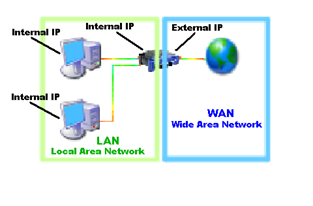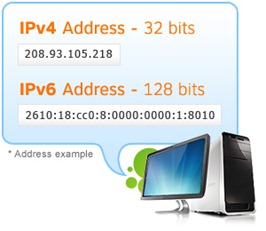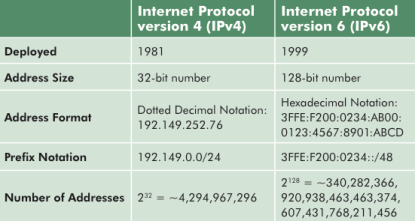The first major version of IP, Internet Protocol Version 4 (IPv4), is the dominant protocol of the internet. Its successor is Internet Protocol Version 6 (IPv6). It was officially launched on 6th June. First let us look at what is Internet Protocol.
The Internet Protocol (IP) is the method or protocol by which data is sent from one computer to another on the Internet. Each computer (known as a host) on the Internet has at least one IP address that uniquely identifies it from all other computers on the Internet.
When you send or receive data (for example, an e-mail note or a Web page), the message gets divided into little chunks called packets. Each of these packets contains both the sender's Internet address and the receiver's address. Any packet is sent first to a gateway computer that understands a small part of the Internet. The gateway computer reads the destination address and forwards the packet to an adjacent gateway that in turn reads the destination address and so forth across the Internet until one gateway recognizes the packet as belonging to a computer within its immediate neighborhood or domain. That gateway then forwards the packet directly to the computer whose address is specified.

Why do we need it?
The explosive growth in mobile devices including mobile phones, notebook computers, and wireless handheld devices has created a need for additional blocks of IP addresses. The growth of the Internet has created a need for more addresses than are possible with IPv4, which allows 32 bits for an IP address, and therefore has 232 (4 294 967 296) possible addresses. IPv6, which was developed by the Internet Engineering Task Force (IETF) to deal with this long-anticipated IPv4 address exhaustion, uses 128-bit addresses, allowing 2128 (approximately 3.4×1038) addresses.

IPv6 and IPv4 share a similar architecture. The majority of transport layer protocols that function with IPv4 will also function with the IPv6 protocol. Most application layer protocols are expected to be interoperable with IPv6 as well, with the notable exception of File Transfer Protocol (FTP). FTP uses embedded network layer addresses to facilitate data transmission. An IPv6 address consists of eight groups of four hexadecimal digits. If a group consists of four zeros, the notation can be shortened using a colon to replace the zeros.
A main advantage of IPv6 is increased address space. The 128-bit length of IPv6 addresses is a significant gain over the 32-bit length of IPv4 addresses, allowing for an almost limitless number of unique IP addresses. The size of the IPv6 address space makes it less vulnerable to malicious activities such as IP scanning. IPv6 packets can support a larger payload than IPv4 packets resulting in increased throughput and transport efficiency.

What it mean to us ?
For most end-users and SMBs, nothing will change, as their computers will continue to connect to the Internet and their favorite services will remain online. However, it is a significant milestone as companies shift their focus to building up their IPv6 infrastructure, and slowly wean off the older IPv4 network.
As was the case for last year's IPv6 Day, most users won't even notice when their ISPs make the switch to IPv6. Part of the reason is because most modern operating systems, including Apple's Mac OS X, most versions of Microsoft Windows, and major Linux distributions, have supported IPv6 addresses for a number of years. Check out your computer's IP address (on Windows machines, type ipconfig at the command prompt): you are most likely going to see the IPv4 address as well as longer string of letters and numbers making up the IPv6 address.
You can test you IPv6 connectivity at http://test-ipv6.com/.
The Internet Protocol (IP) is the method or protocol by which data is sent from one computer to another on the Internet. Each computer (known as a host) on the Internet has at least one IP address that uniquely identifies it from all other computers on the Internet.
When you send or receive data (for example, an e-mail note or a Web page), the message gets divided into little chunks called packets. Each of these packets contains both the sender's Internet address and the receiver's address. Any packet is sent first to a gateway computer that understands a small part of the Internet. The gateway computer reads the destination address and forwards the packet to an adjacent gateway that in turn reads the destination address and so forth across the Internet until one gateway recognizes the packet as belonging to a computer within its immediate neighborhood or domain. That gateway then forwards the packet directly to the computer whose address is specified.

Why do we need it?
The explosive growth in mobile devices including mobile phones, notebook computers, and wireless handheld devices has created a need for additional blocks of IP addresses. The growth of the Internet has created a need for more addresses than are possible with IPv4, which allows 32 bits for an IP address, and therefore has 232 (4 294 967 296) possible addresses. IPv6, which was developed by the Internet Engineering Task Force (IETF) to deal with this long-anticipated IPv4 address exhaustion, uses 128-bit addresses, allowing 2128 (approximately 3.4×1038) addresses.

IPv6 and IPv4 share a similar architecture. The majority of transport layer protocols that function with IPv4 will also function with the IPv6 protocol. Most application layer protocols are expected to be interoperable with IPv6 as well, with the notable exception of File Transfer Protocol (FTP). FTP uses embedded network layer addresses to facilitate data transmission. An IPv6 address consists of eight groups of four hexadecimal digits. If a group consists of four zeros, the notation can be shortened using a colon to replace the zeros.
A main advantage of IPv6 is increased address space. The 128-bit length of IPv6 addresses is a significant gain over the 32-bit length of IPv4 addresses, allowing for an almost limitless number of unique IP addresses. The size of the IPv6 address space makes it less vulnerable to malicious activities such as IP scanning. IPv6 packets can support a larger payload than IPv4 packets resulting in increased throughput and transport efficiency.

What it mean to us ?
For most end-users and SMBs, nothing will change, as their computers will continue to connect to the Internet and their favorite services will remain online. However, it is a significant milestone as companies shift their focus to building up their IPv6 infrastructure, and slowly wean off the older IPv4 network.
As was the case for last year's IPv6 Day, most users won't even notice when their ISPs make the switch to IPv6. Part of the reason is because most modern operating systems, including Apple's Mac OS X, most versions of Microsoft Windows, and major Linux distributions, have supported IPv6 addresses for a number of years. Check out your computer's IP address (on Windows machines, type ipconfig at the command prompt): you are most likely going to see the IPv4 address as well as longer string of letters and numbers making up the IPv6 address.
You can test you IPv6 connectivity at http://test-ipv6.com/.
This comment has been removed by a blog administrator.
ReplyDelete